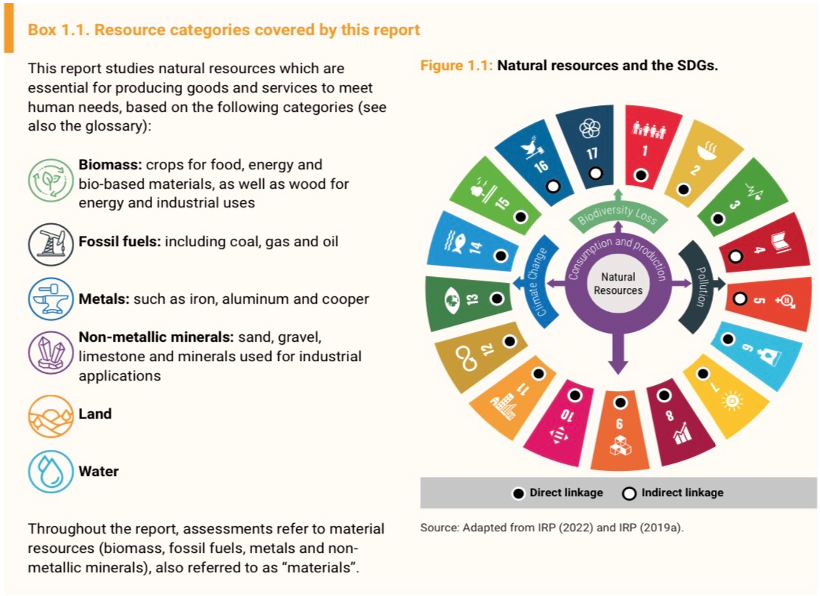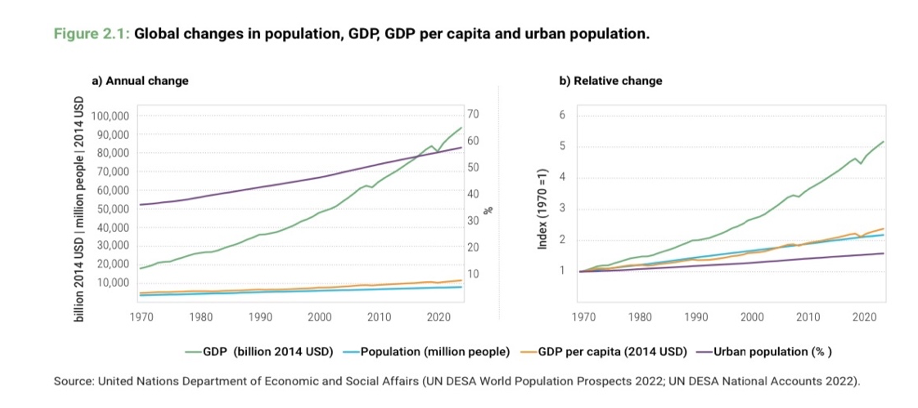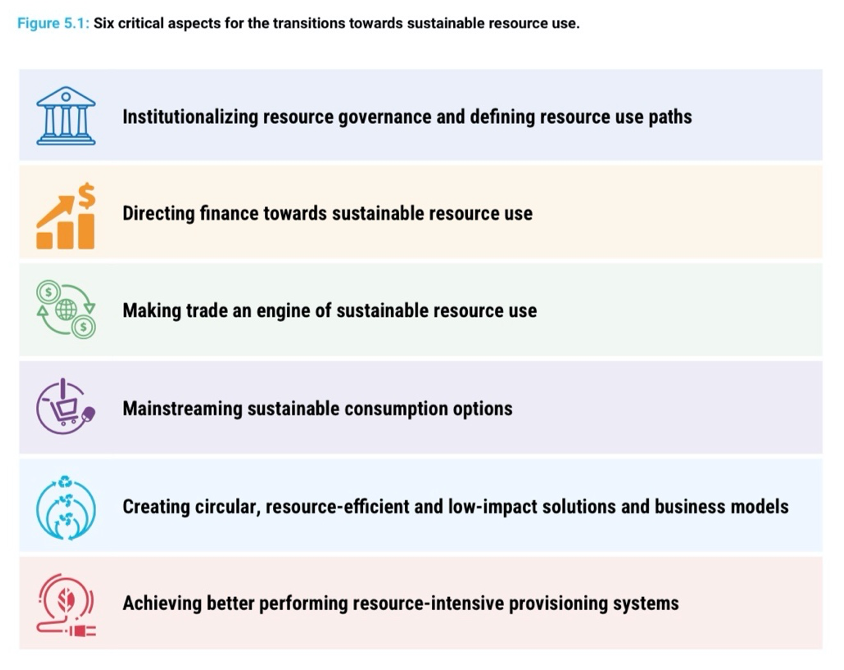

23/04/2024
Global Resources Outlook 2024 was written under the auspices of the International Resource Panel (IRP) of the United Nations Environment Programme (UNEP) and Janez Potočnik, Izabella Teixeira - co-chairs of the IRP, the members of the IRP and its Steering Committee. The report shows that it is both possible and profitable to decouple economic growth from environmental impacts and resource use.
Sustainable resource use and consumption can reduce resource use and environmental impacts in wealthier countries, while creating the space for resource use to grow where it is most needed. It is important to note that the circular models we must follow are not just about recycling; they are about keeping materials in use for as long as possible, and rethinking how we design and deliver goods as well as services, thereby creating new business models. If the policies and shifts outlined in this report are followed, the 2060 picture will be significantly rosier than under current models. We could have a global GDP three per cent larger than predicted and reduced economic equalities. Growth in material use could fall by 30 per cent. Greenhouse gas emissions could be reduced by more than 80 per cent. Such results would be a huge win for people and planet. The bottom line is that sustainable and responsible resource use and consumption is a key enabling factor for the success of virtually every international agreement and initiative aimed at carving out a better future – from the new Global Framework on Chemicals and upcoming legally binding instrument on plastic pollution to the Paris Agreement and the Sustainable Development Goals.
1. Transformation in resource consumption and production
The global economy is consuming ever more natural resources. The prevailing resource extraction and use models are a contributing and major causal factor of what is known as the triple planetary crisis (climate change, biodiversity loss and pollution). Moreover, natural resource use is highly unequal and creates strong differences in the distribution of costs and benefits, with the poor particularly disadvantaged throughout the cycle of use. The current model also fails to deliver acceptable human development conditions for many on the planet. Without a systemswide shift towards sustainable resource use, the current trajectories will contribute further to the surpassing of planetary boundaries and the inequalities that are characteristic of the global economy. This has also been framed as humanity transgressing a safe operating space. This Global Resources Outlook 2024 report brings together the best available data, modelling and assessments to analyse trends, impacts and distributional effects of resource use. It also describes the potential to turn negative trends around and put humanity on a trajectory towards sustainability.

Natural Resources and the Sustainable Development Goals (SDGs)
2. Drivers, pressures, and natural resource use trends
The growing global population, expanding economy, rapid urbanization and a growing middle class have increased the demand for resources such as materials, water and land, putting pressure on these natural resources. This report delves into the effects of these factors, including economic and population growth, as well as urbanization and industrialization, by evaluating global trends in the demand for materials, water and land.
According to the report, over the past 50 years, there have been notable changes in economic output, population trends, individual income and urbanization patterns. In 1970, global GDP stood at approximately 18 trillion US dollars (based on 2014 prices). This figure is projected to surge by over five times, reaching USD 93 trillion by 2024, as shown in Figure 2.1. By comparison, global population rose from 3.7 billion to 8.1 billion during this time frame. These shifts in economy and population led to an increase in GDP per capita from USD 4,882 in 1970 to USD 11,591 by 2024. This economic growth significantly enhanced the material wellbeing and quality of life for millions, especially in the Global South. As the world further urbanizes and industrializes, the strain on environmental systems intensifies, leading to exacerbated environmental consequences. Between 1970 and 2024, the proportion of the global population residing in cities is projected to rise from 37% to 58%, as depicted in Figure 2.1. Such trends imply profound consequences for the consumption of natural resources and environmental transformations, both on a global and regional scale.

Figure 2.1: Global changes in population, GDP, GDP per capital and urban population
3. Sustainable resource management is urgently needed
The triple planetary crisis of climate change, biodiversity loss and pollution increasingly threatens the future of society. Climate change impacts are already evident worldwide, but national pledges for greenhouse gas reductions still fall short of meeting the required level to maintain the Paris target (UNEP 2021b). Similarly, species extinction rates are tens to hundreds of times higher than the average rate over the past 10 million years, and the pace is accelerating (IPBES 2019a). Resource extraction, processing and use make a significant contribution to these and other environmental impacts. This report provides an update of the development of resource-related impacts up to 2022 and shows the gap in terms of reaching targets for climate change and biodiversity loss impacts. It also shows which impacts are caused by provisioning systems. This helps to understand the status quo, historic trajectories, environmental hotspots, improvement potential and the need for action for sustainable global resource management, with the goal of achieving a high level of well-being while keeping impacts to an acceptable level and in line with global environmental goals.
4. Call to action for sustainable resource use
In 2024, the world faces sustainability challenges of unprecedented proportions, posing increasing impacts and risks. This report demonstrates how the triple planetary crisis of climate change, biodiversity loss and pollution is strongly connected to the use and production of natural resources. At the same time, resources are critical for delivering human development across the globe. The report also shows how inequitable, ineffective and inefficient current resource use patterns are: while there has been progress in delivering on some of the Sustainable Development Goals (SDGs), global action is not on track to meet goals on ending hunger, access to clean drinking water and sanitation or access to clean energy, among many others by 2030 (SDG tracker 2023). The systems providing us with food, mobility, energy and shelter are responsible for the majority of resource related global impacts including 70% of climate impacts, more than 75% of biodiversity loss and almost 80% of health burden impacts due to pollution. Furthermore, these impacts greatly exceed internationally agreed climate and biodiversity targets. Moreover, this report shows the unequal distribution of the benefits and impacts from resource use along the value chain: on a per capita basis, high-income countries cause more than 10 times more climate impacts to obtain provisioning systems of food, energy, mobility and built environment than low- and lower middle-income regions. In 2022 alone, more than half of global land-related biodiversity loss occurred in Africa and Latin America due to the extraction of biomass for agriculture and forestry, a great share of which was consumed in higher income countries. However, less than 5% of global value added was generated in those regions. Conversely, almost half of the total global value added of resource use was generated in Europe and North America, while less than 10% of global water stress and biodiversity loss occurred in these regions. Addressing this reality, based on evolving concepts of a just transition, is an essential part of any credible and justifiable way forward (see Box 5.1). While policy responses to mitigate environmental pressures have proven successful in some cases, the scenario modelling undertaken in this report shows that without fundamental changes it will not be possible to achieve multilateral global climate, biodiversity, pollution and land degradation goals and agreements. For instance, the Historical Trends scenario (which includes current policies agreed to by countries) shows that current Nationally Determined Contributions under the UN Framework Convention on Climate Change (UNFCCC) will still lead to an overshoot of 2 degrees Celsius warming. Loss of natural habitats is also expected to increase

Figure 5.1: Six critical aspects for the transitions towards sustainable resource us
5. Recommendations for sustainable resource use
It is vital to explicitly recognize and integrate the use and production of resources at the core of the global sustainability agendas of climate, biodiversity and pollution, while acknowledging the resource-use implications of existing multilateral climate and biodiversity goals. It is also essential to understand which resource-use paths could meet the goals of these interconnected sustainability agendas. This report gives some recommendations for sustainable resource use:
Global and national institutionalization of resource use in sustainability agendas and environmental agreements: The effectiveness of implementing such a recommendation will depend on the quality of governance institutions at country level and of resource governance mechanisms in particular, for which the picture is very uneven across countries.
Defining global and national resource use paths: It is essential to define resource use paths and targets at the global, national and other governance levels in order to monitor progress towards sustainable resource use. Setting targets is an effective way to lead transitions, at least when the implementation instruments are coherent. Targets need to be sufficiently ambitious and be clearly and authentically linked to climate, biodiversity, land degradation and pollution impacts and goals. These targets could be translated into an internationally agreed pathway for resource use (materials, land and water), considering the differential impacts of different resource categories.
Internalizing the environmental and social costs of resource extraction: Regulation, such as a tax on impacts caused by virgin resource extraction, would help to incentivize the use of secondary materials and increased efficiency in production, as well as internalizing environmental and social costs. As well as encouraging resource efficiency, this also enables a modest shift of taxation away from income and consumption. Ideally, such a tax would take into account the impacts of resource extraction, rather than being purely based on tonnes extracted.
Redirecting, repurposing and reforming public subsidies for sustainable resource use: Aligning public spending with humanity’s long-term interests means aligning subsidies with sustainable resource use. This means redirecting, repurposing, reforming or eliminating economic incentives that contribute to unsustainable resource use and drive the triple planetary crisis, as well as scaling up subsidies for sustainable resource use practices.
Channelling private finance towards sustainable resource use: Besides scaling up public finance for sustainable resource use, public and private actors can channel private financial flows in the same direction. Frameworks can play an important role in scaling up sustainable finance. To overcome these weaknesses, an overarching taxonomy for sustainable resource use should aim to: correspond to specific sustainable resource use objectives, in alignment with other environmental goals (such as the Paris Agreement and Post-2020 Global Biodiversity Framework); monitor achievement against specific indicators; and shift from voluntary to mandatory transparency against specific resource-related targets.
Incorporating resource-related risks in public and central bank mandates: Redefining finance for sustainable resource management involves a consideration of financial system regulators, public financial regulatory bodies and central banks. Central banks should make reducing resource-related risk and priority in their mandates – as some pioneering central banks are doing for climate and biodiversity risk.
Trade governance for fair and sustainable resource use: Changes to trade governance that recognize and reflect the (externalized) environmental and social costs of resource extraction could help extractors and producers to implement sustainable production practices. Incorporating these externalities would create a level playing field, preventing a race to the bottom on environmental standards along resource value chains.
Enabling local resource value retention in producer countries: Local communities and host governments in producer countries are looking for real shared value from resource extraction, as opposed to the current unequal exchange. They seek to use their non-renewable resources to achieve long-term and sustainable growth in living standards, while also safeguarding their natural environments through local value added (for instance by retaining monetary value in resource-extraction areas).
Developing action plans to improve access to affordable and sustainable goods and services: Action plans to ensure that sustainable goods and services are available and affordable should include measures to make sustainable options accessible, economically competitive and socially acceptable. This would require regulation, a shift towards resource pricing to reflect the environmental cost of resource extraction and use as well as removing harmful subsidies and channelling of subsidies towards low-resource intensive, low-impact options. Reducing prices could be particularly challenging for some products and services.
Raising awareness and regulating marketing practices that lead to overconsumption: For sustainable alternative goods and services to thrive, they also need to be desirable and socially accepted. Currently, enormous amounts of money are invested in advertising resource-intensive products. It is therefore crucial to guide marketing practices towards sustainable options, including business-to-consumer and business-to-business marketing, and covering both physical and e-commerce. Removal of information barriers to sustainable consumption is needed for that.
Setting up monitoring and evaluation systems to establish priorities and developing ambitious action plans for a circular economy: There is often little quantitative evidence for the effectiveness of circular economy strategies to mitigate impact. Moreover, assessments often refer to potential savings rather than real effectiveness. In addition, circular economy measures assessed by the literature often focus on incremental rather than systemic changes. Therefore, one important priority is to develop monitoring systems to establish priorities for action and to serve as a basis for developing action plans.
Developing and reinforcing regulations to boost circular economy business models: To increase energy and material efficiency, reduce waste generation and ensure that the products brought to market are safe and more circular, the regulatory framework needs to favour circular economy business models. It should also promote the development of innovative approaches and demonstrative examples, which could then be scaled up.
Building circular economy capacity and coalitions: It is essential to build capacity and adapt skills to develop and scale up new practices, technologies and business models. Deploying resource efficiency and circular economy strategies is expected to increase jobs in the relevant sectors (OECD 2020d). New skills will be needed for bridging the technology, labour and information requirements of new forms of processing materials and products. Less industrialized countries could benefit from building on existing circular business models including those that have emerged in the informal sector. To support capacity building, research and innovation should be encouraged across public and private sectors. It is also crucial to prioritize the development and/ or reinforcement of platforms for sharing resource efficiency and circular economy ideas and making use of existing ones.
Nhâm Hiền
(Source: Global Resources Outlook 2024)
(Source: Vietnam Environment Administration Magazine, English Edition I-2024)